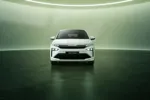“With the new format registration number comes a whole new set of rules about actually purchasing a plate. If a plate has to be replaced, for example if the vehicle is in an accident, the only way to get a new one is from a licensed supplier. The driver then has to produce personal identification, such as a driving licence or passport. They also have to give proof of ownership, which could be harder to obtain. For example, showing a copy of the V5 could be difficult in the case of a rental or lease car, as it will be held by the owner.
The real problem is that the supplier of the plate has to put their name and postcode on it. So if a vehicle has an accident the supplier, which can be the bodyshop, has their details plastered over the plate. When it comes to disposal time and the plate on the rear has the original supplier and the one on the front has the name of the bodyshop, alarm bells will start ringing with potential buyers. Practices need to be put in place to ensure that front and rear plates carry the same name. Leasing companies need to ensure that whoever the repairer is, replacement plates come from the original supplier. Not an easy process to put into place, but an important one when it comes to selling time.
On a less serious note, we know that everybody strives to have the newest car on the block, as twice a year plate changes make cars look older than they really are. So it is with S plates which, though only a couple of years old, look significantly older. But the new plate may help to smooth away the wrinkles, and make an older car look younger. How? If the car is lucky enough to have '151' as part of the number plate, it is easy to make it look like new. If the owner lives in London a plate like L151 ABC can instantly knock years off a car, as it could be seen as LI 51. Or somebody from Scotland could have S151 ABC, and the neighbours will be shuffling the curtains to look at next door's new car. When next March comes around it will be those with '102' that look younger; Y102 ABC, and hey presto, a brand new car from Yorkshire. Simply change the plates to the new mandatory font, with a blue Euro emblem, and off you go. The confusion arises because the number '1' on a new plate does look like an 'I' and could be seen as part of the regional identifier. The fact that 'I' isn't used under the new system really is irrelevant, because many people won't realise this. This can work the other way around however. I know of one customer in Yorkshire who just collected his brand new car and was seriously unhappy because the regional identifier began with a 'Y' – the same letter as the outgoing plate system. As used car disposers, will it be possible to ask more for an old car with a 'current' plate on it? Probably not, but it is an interesting proposition.
I was at a manufacturing plant last week and was astounded to see just how many of the same colour cars were going down the line. We estimated that over 50 per cent were in silver. Many were bound for Europe, so it is not only the UK public that is mass buying this ever-popular colour. If the trend continues, used car buyers could be left with very little choice in the next few years. Just like back in Henry Ford's days, but now it is any colour you want so long as it is silver.
Fiat Puntos have been a rare sight at rental disposal sites for a number of months, but there have been a few about recently. The used car boys, particularly non-franchise dealers, love them and pay strong money for them. I am told that there are very few left now on fleets that are 'on risk' which is a pity, as they have always done well. If they were about in numbers they would continue to be snapped up. Some manufacturers like to keep a tight rein on their vehicles and don't necessarily like nearly new cars hitting the open market. In some cases though, the Punto being one of them, it doesn't harm residuals to be sold outside the franchise network; in fact it often helps them, provided that the market isn't flooded."















Login to comment
Comments
No comments have been made yet.